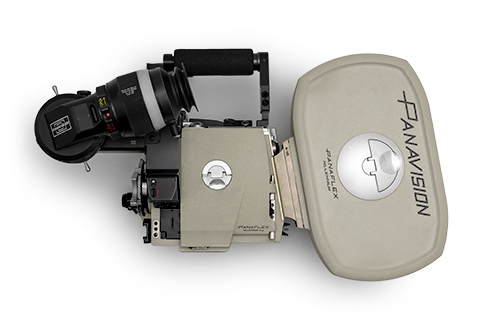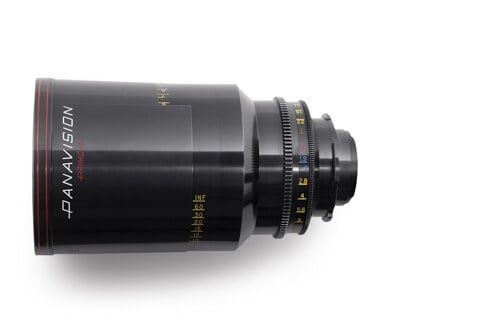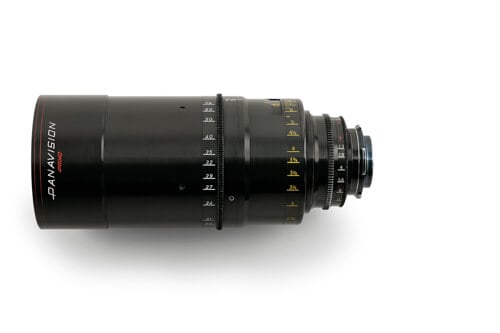Filming Cameron Monaghan’s short film Foxbody on 3-perf 35mm
-6416x3605-3f75a23.jpg?sfvrsn=f0388723_1)
Actor Cameron Monaghan makes his directorial debut with the short film Foxbody, a stylized thriller that embraces the dark aesthetics of neo-noir. To achieve this vision, he collaborated closely with cinematographer Aislyn Murray; partnering with Panavision, the pair opted for 35mm film, using a Panaflex Millennium XL2 camera and Primo prime and zoom lenses to capture the film's essential look. In the following interview, Monaghan and Murray reveal the inspirations behind the film's look, detail their collaborative process, and discuss the artistic impact of their technical choices.
Panavision: How would you describe the look of Foxbody?
Cameron Monaghan: While Foxbody is a rather dark thriller with western and neo-noir influences, I wanted to retain a sense of color, saturation and even playfulness in the design. However, it was important to find a balance between a heightened reality and naturalism.
The story is set in Texas in the 1980s, and I immediately started drawing inspiration from reference photos and films of that time. It was apparent from the jump that we needed to shoot on celluloid, giving a sense of density, grit and authenticity. Our color palette was tightly controlled. I spoke in depth with our costume designer, Lyn Paolo, and production designer, Kelly Pennington, about what I felt was important to control and emphasize. Certain colors, like red, were tightly limited, while others, such as blue, were nearly completely eradicated, allowing elements like orange and green to shine in surprising ways. As the story deepens in its surrealism, I wanted to reflect this in some bold lighting choices. I’m very proud of the work Aislyn and gaffer Evan Cox did for this sequence in particular.
Aislyn Murray: Foxbody is a film that narrows in on the choice of color in a world of dusty tans and baby-blue skies. The saturation and wash of color, at times, is more present than a traditional desolate western palette. The film feels nostalgic for an era like the ’80s, using dominant reds and greens in the frame when it's a reflection of the character.
We wanted any artificial sun to feel intimate and warm. Evan, my amazing gaffer, loved the quality of older tungsten units to get a richness of skin tones, especially on our 500T film stock. I'll use tungsten units whenever possible, so that wasn't a hard sell for me.
Aside from lighting, there is a decent amount of action in the script, so the movement of the camera was important. As the tone of the film progresses, so does the camera movement. Our operator, Adeshola Adigun, really heightened the tone with how much he dances around our characters, whether it be on a dolly or Steadicam.
-1000x907-3b2f6fe.jpg?sfvrsn=3b30f5bb_1)
Were there any particular visual references you turned to for inspiration?
Monaghan: When pitching the short, I would describe it as early Coen Brothers by way of David Lynch. While there are definitely elements of their films in Foxbody — in particular, I screened Blood Simple and Wild at Heart for our crew — it became apparent quite quickly that we were going for a particular tone.
Murray: Cameron took the initiative to have as many crew members as possible watch Blood Simple and Wild at Heart, two amazing films that, when combined, create whimsical, dangerous and exciting visuals. Those were big references for me to keep in the back of my mind. Wild at Heart is so vibrant and evocative. It's one of my favorite Lynch films.
I also love No Country for Old Men — I think it's a masterclass in character, which inherently impacts the way you frame your subjects, action and light, among other things. However, Foxbody is so different from Deakins' work on the film that I used it more as a philosophy when approaching a neo-western. I wanted to maintain a connection between the character and the environment in my framing, using the film as a guideline on how to shoot them, not copy the look of a film that I love.
Monaghan: The idea was taking the trappings of a classic western and shifting the perspective, preoccupations, morality and basic suppositions. That meant a cinematic language that generally dipped into a more art house and, I hope, feminine perspective. Looking back at all my boards, I have references to Wong Kar-Wai, Lynne Ramsay, Derek Cianfrance, Alfonso Cuarón, Michael Haneke, Wim Wenders and many more. Most of these works are not literal homages but rather reflect on a lifetime of admiration and hopefully putting them in a subconscious blender from the writing phase onward. I’m also a massive fan of the painter Edward Hopper, and I look for the opportunity to block actors through windows and frames whenever I get the chance.
-1000x907-51ad152.jpg?sfvrsn=5753667_1)
What brought you to Panavision for this project?
Murray: I worked at Panavision for a few years after college. They taught me a lot of what I know technically, and I got the opportunity to study all of their cameras and lenses closely. It was a time I could experiment and develop my preferences. Rik DeLisle, our marketing rep, loved hearing about the script, and as always, he and Panavision foster an environment to help narrative filmmakers. Cameron and I were in good hands from the start.
Monaghan: While I have been a hobbyist film photographer since my teens, I have become much more of a gear nerd in the last few years. I have made it a habit when I enjoy a film visually, particularly vintage pictures, to research the camera, lens and film stock. It will come as no surprise to anyone that most of the films I admire were shot on Panavision glass. When I first met with Aislyn to discuss this project, she mentioned that she had worked at Panavision. We quickly formulated a plan to get our hands on Panavision gear.
At the time, the combo of Primo lenses and the XL2 body felt like a pipe dream, but Panavision was incredibly supportive. Our camera kit, as well as Aislyn and her team’s talent, really brought out the best of the Kodak 500T stock. We opted for a three-perf 1:85 frame, not only for the longer roll times but also for a taller aspect ratio to accommodate a particular dance scene and how we wanted to frame the actors.
Murray: When people ask me, ‘What is your favorite camera?’ I have said, on more than one occasion, the XL2. The movement inside the camera is a work of art. It runs so smoothly and is one of the more silent 35mm film cameras. The viewfinder is so clear and really gives me a sense of confidence when operating, even when handheld in a convertible, tearing down a dirt road. We entertained using the GII and 2-perf for cost and aspect ratio, but the lightweight specs of the XL2 and the 3-perf 1.85 aspect ratio felt right for Foxbody. We did an in-house test for the film stock, lighting and lenses. I felt right at home with the XL2 immediately.
Panavision's cameras and lenses have a legacy that added a sense of importance to what we were capturing on celluloid. The Panavision XL2 camera and Primo lenses have held up through decades of use, and the aesthetic quality has stood the test of time. The look was completed with Kodak 5219 500T film, and I would love to use this trio in the future.
-1000x907-51ad152.jpg?sfvrsn=bfa483e7_1)
What optical characteristics did you see in the Primos that made them feel right for this project?
Monaghan: The Primo lenses had the perfect amount of character while still feeling relatively clean, with gorgeous color rendition that felt classic but not dated.
Murray: I've used a variety of Panavision lenses on my shoots and love each set for different reasons. The style that Cameron and I wanted for this film was something sharp, classic and strong. I think the Primos have such a good contrast built into the glass, which is important to me when controlling the look on set. I love that the Primos hold up well wide open at T1.9. A majority of the film was at a slower stop than that to highlight the environment and production design, but they had a clear depth that was present at every T-stop and highlighted the characters nicely in close-ups. The rendition and falloff feel natural and classic, especially for display on a theater screen.
Cameron, how did you and Aislyn communicate with one another over the course of production?
Monaghan: We worked incredibly closely across preproduction. Visual language is very important to me as a filmmaker. Regardless of whether some may consider it a faux pas, I like to write my camera into my scripts. I storyboarded and shot-listed the project from top to bottom. But it wasn’t simply what was being shot, but how. Aislyn and the team we assembled were gung-ho to figure out the more challenging or abstract ideas without hesitation.
I had researched her work before bringing her on and really admired not only the fact that she wasn’t afraid to get experimental but also how she always managed to maintain an organic or tactile sensibility to the compositions. Not only was her cinematography and operating integral to the project, but she recommended crew like Evan or our Steadicam op, Adeshola, who were massive value-adds.
-1000x907-51ad152.jpg?sfvrsn=36ee9f97_1)
How does this project differ from others in both of your careers?
Monaghan: This project is a series of firsts for me. While I have been an on-camera actor for over 25 years, I had never directed a project formally. While I had picked up cameras in friends’ backyards, as part of classes, or to train as a concept, I had never been at the helm of a large-scale crew. While most actors-turned-directors tend to get a start by directing an episode of a TV show they’re working on, I didn’t want to feel grandfathered or backdoored into it. I think that’s a great and completely valid way to get started, but it never felt right for me.
I was raised in cinema, and perhaps it’s a foolish or purist sentiment, but I really wanted my first foray to be something built from the ground up, written and designed to have my voice, to be truly representative of where I am at this current age and time. So, we assembled 50-odd of the best crew we could find and launched into something that felt ambitious and audacious. The goal was to bite off a bit more than anyone would expect we could chew — cars, guns, locations, action — and prove that we could swallow it. It wasn’t easy on a three-day shoot, but we were scrappy and managed to push our way through.
Murray: Cameron has a really unique experience of being an on-screen actor. As a cinematographer, I've never worked with someone where they made the leap from seasoned actor to director, writer, producer and lead of their own short. This brought a new perspective to my process on set as Cameron has a rhythm that is very mindful of the idea that when we slate, we're fully in the scene. He never really missed a moment, a look, a line, and I know that comes from his career experience. What was rewarding for me as a collaborator was to see him perform on such a focused level, then immediately switch hats and express himself in a new way from behind the camera. I felt like I connected to my subject in a different way than any other narrative I've shot.


